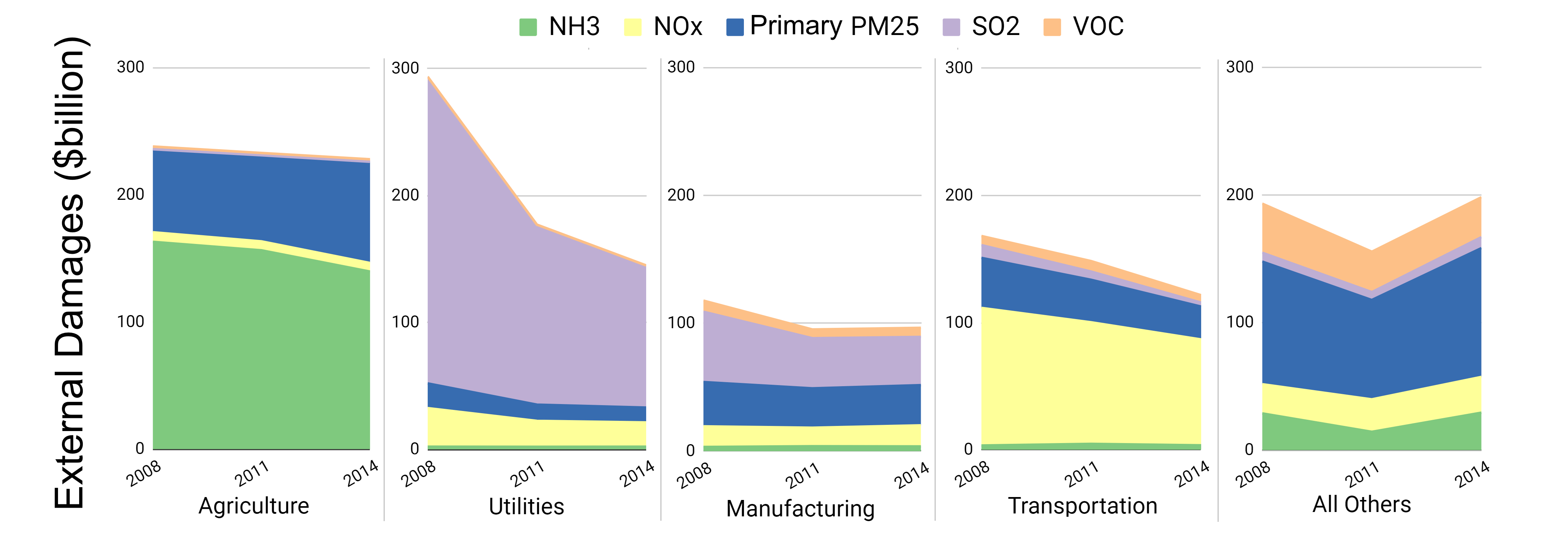How much does air pollution cost the U.S.?
Damages from air pollution have fallen dramatically in the U.S. in recent years, shows new research. But how different sectors of the economy have contributed to that decline is highly uneven.
Air pollution negatively impacts the U.S. economy, costing the U.S. roughly 5% of its yearly gross domestic product (GDP) in damages ($790 billion in 2014). The highest costs come from early deaths, attributable to exposure to fine particulate matter (PM2.5).
However, damages from air pollution in the U.S. are sharply falling, as levels of outdoor air pollutants have decreased in recent years, according to recent research from the Center for Air Quality, Climate, and Energy Solutions (CACES) at Carnegie Mellon University. The study, published in this week’s issue of the Proceedings of the National Academy of Sciences, shows that external damages from air pollution have fallen 20% recently over just a six-year span (2008 to 2014).
“It is a really a sharp decline,” says Nick Muller, professor engineering and public policy (EPP) and economics (Tepper School of Business).
We know the economy changed a lot between 2008 and 2014. (Those changes) all show up in air pollution damages.
Nick Muller, Associate Professor, EPP/Tepper
While some PM2.5 in the atmosphere is the result of natural processes, such as forest fires or windblown dust, the majority of the damages from PM2.5 are related to human activities, most of which can be attributed to different sectors of the economy, such as manufacturing and agriculture. Combining damages with more traditional measures of economic production, such as GDP or value-added, provides a more accurate picture of a sector’s full economic impact.
“We know the economy changed a lot between 2008 and 2014,” said Muller, pointing to a wide range of economic trends, such as the rise of cleaner energy sources like natural gas and renewables amidst the decline of higher-polluting coal, the retirement of some heavier manufacturing industries, and even the Great Recession where economic production (and thus emissions) slowed. “They all show up in the air pollution damages.”
Damages attributable to the utilities sector fell dramatically from 2008 to 2014, by more than 50%. More modest were decreases in other large economic sectors, such as manufacturing (20%), transportation (30%), and agriculture (4%). Agriculture ($230 billion in air pollution damages in 2014) has now replaced utilities ($150 billion in 2014) as the economic sector with the highest level of damages, according to the study.

Source: Nick Muller, Ines Azevedo, & Peter Tschofen
Above image: External damages from fine particulate matter air pollution by economic sector and precursor pollutant for 2008, 2011, and 2014 (in billions of dollars, 2018-adjusted).
Air pollution damages are largely concentrated within a small number of economic sectors: the top four sectors responsible for the highest external damages (agriculture, utilities, manufacturing, and transportation) contribute just under 20% of GDP, but are responsible for more than 75% of all air pollution-related damages.
PM2.5 can be emitted directly into the atmosphere (as “primary” PM2.5) or formed through atmospheric chemical reactions that slowly turn emitted gases into PM2.5 (“secondary”). Disparate economic activities, from agriculture to power generation to water transportation, each contribute their own unique mix of chemicals to the atmosphere, but each ultimately contributes to PM2.5. The study tracks the magnitude of damages arising from each major category of emissions within each part of the economy.
Utilities-related damages, for example, are largely driven by sulfur dioxide (SO2), a by-product of coal combustion, which forms secondary PM2.5 downwind of the smokestacks it comes from. Decreases in SO2have driven down damages from utilities in recent years. Ammonia, the largest contributor of damages from agriculture, is emitted through both livestock-raising and fertilizer application, forming secondary PM2.5 downwind of farms.
“The chemical composition of damages is very different across the different sectors, and so you can’t treat the sectors the same,” said corresponding author Peter Tschofen, Ph.D. student in EPP. He and former CMU professor Ines Azevedo, now an associate professor at Stanford University, are Muller’s co-authors on the study.
Understanding the magnitude of damages from ammonia emissions compared to those from sulfur-dioxide, for example, and which economic sectors those damages correspond to, should help policymakers know where to focus their resources to further lower PM2.5 damages.
Like agriculture and utilities, each sector has its story of damages from its emissions. “This study shows where we need to do technological research to develop options for emissions controls,” said Muller. In the case of agriculture, unlike sulfur dioxide scrubbers at coal plants, technologies are not readily available to help reduce the ammonia being emitted across a tract of land.
“The damage calculations we’ve made are a key ingredient to inform future policy analyses” with both R&D and regulation in mind. “What I would urge a policy-maker to do when prioritizing future regulations,” said Muller, “is to look at the marginal cost of reducing emissions, both by sector and by pollutant” compared to the damages of not doing so.
Such recommendations will be further refined in the team’s follow-up work, which will focus on how damages from each sector are distributed across the country, as not all emissions are equal. Pollutants emitted in close proximity to urban areas do far more harm than those emitted where few people are around to breathe the dirty air.
